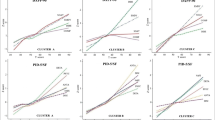Abstract
Levels of convergence were examined among three personality instruments: the Personality Diagnostic Questionnaire-4+ (PDQ-4+), the Structured Clinical Interview for DSM-IV Axis II Personality Disorders Questionnaire (SCID-IIQ) and the Multi-source Assessment of Personality Pathology (MAPP). Each personality questionnaire was administered three times in an alternating sequence over nine consecutive weekdays to a sample of college students. There was some degree of convergence among the three instruments, but there were also substantial empirical differences between them. The data suggest three related conclusions: (1) in general, the self-report version of the MAPP is more conservative than the other two questionnaires, (2) these questionnaires are not interchangeable measures of personality disorders, and (3) the breadth of measurement provided varies as a function of both the questionnaire and the personality disorder being measured.
Similar content being viewed by others
Notes
It is recognized that it is not appropriate to make “diagnoses” of personality disorders without administering a semi-structured interview. In this paper, the term “diagnosis” is used simply to note that the individual met or exceeded the number of criteria needed to make diagnoses.
References
Clark, L. A. (2007). Assessment and diagnosis of personality disorder: Perennial issues and an emerging reconceptualization. Annual Review of Psychology, 58, 227-257.S84.
Davison, S., Leese, M., & Taylor, P. J. (2001). Examination of the screening properties of the Personality Diagnostic Questionnaire 4+ (PDQ-4+) in a prison population. Journal of Personality Disorders, 15, 180–194.
Ekselius, L., Lindstrèom, E., von Knorring, L., Bodlund, O., & Kullgren, G. (1994). SCID II interviews and the SCID Screen questionnaire as diagnostic tools for personality disorders in DSM-III–R. Acta Psychiatrica Scandinavica, 90, 120–123.
Grant, B. F., Stinson, F. S., Dawson, D. A., Chou, S. P., & Ruan, W. J. (2005). Co-occurrence of DSM-IV personality disorders in the United States: Results from the National Epidemiological Survey on Alcohol and Related Conditions. Comprehensive Psychiatry, 46, 1-5.
Hyler, S. E. (1994). The personality diagnostic questionnaire 4+. New York: New York State Psychiatric Institute.
Hyler, S. E., & Rieder, R. O. (1987). PDQ-R: Personality Diagnostic Questionnaire-revised. New York: New York State Psychiatric Institute.
Hyler, S. E., Skodol, A. E., Kellman, H. D., Oldham, J. M., & Rosnick, L. (1990). The validity of the Personality Diagnostic Questionnaire: a comparison with two structured interviews. American Journal of Psychiatry, 147, 1043–1048.
Hyler, S. E., Skodol, A. E., Oldham, J. M., Kellman, H. D., & Doidge, N. (1992). Validity of the Personality Diagnostic Questionnaire-Revised: a replication in an outpatient sample. Comprehensive Psychiatry, 33(2), 73–77.
Jacobsberg, L., Perry, S., & Frances, A. (1995). Diagnostic agreement between the SCID-II screening questionnaire and the Personality Disorder Examination. Journal of Personality Assessment, 65, 428–433.
Klein, D. N. (2003). Patients’ versus informants’ reports of personality disorders in predicting 7 1/2 year outcome in outpatients with depressive disorders. Psychological Assessment, 15, 216–222.
McDermut, W., & Zimmerman, M. (2005). Assessment instruments and standardized evaluation. In J. M. Oldham, A. E. Skodol, & D. S. Bender (Eds.), Textbook of personality disorders. Washington, D.C.: American Psychiatric.
Lenzenweger, M. F., Lane, M. C., Loranger, A. W., & Kessler, R. C. (2007). DSM-IV personality disorders in the National Comorbidity Survey Replication. Biological Psychiatry, 62, 553-564.
Oltmanns, T. F., & Turkheimer, E. (2006). Perceptions of self and others regarding pathological personality traits. In R. F. Krueger, & J. L. Tackett (Eds.), Personality and psychopathology (pp. 71–111). New York, NY: Guilford.
Oltmanns, T. F., Turkheimer, E., & Strauss, M. E. (1998). Peer assessment of personality traits and pathology in female college students. Assessment, 5, 53–65.
Perry, J. C. (1992). Problems and considerations in the valid assessment of personality disorders. American Journal of Psychiatry, 149, 1645–1653.
Skodol, A. E., Oldham, J. M., Rosnick, L., Kellman, H. D., & Hyler, S. E. (1991). Diagnosis of DSM-III-R personality disorders: a comparison with two structured interviews. International Journal of Methods in Psychiatric Research, 1, 13–26.
Spitzer, R. L., Williams, J. B. W., Gibbon, M., & First, M. B. (1990). User“s guide for the structured clinical interview for DSM-III-R: SCID. Washington, DC: American Psychiatric.
Thomas, C., Turkheimer, E., & Oltmanns, T. F. (2003). Factorial structure of personality as evaluated by peers. Journal of Abnormal Psychology, 112, 81–91.
Torgersen, S., Kringlen, E., & Cramer, V. (2001). The prevalence of personality disorders in a community sample. Archives of General Psychiatry, 58, 590–596.
Westen, D. (1997). Divergences between clinical and research methods for assessing personality disorders: Implications for research and the evolution of Axis II. American Journal of Psychiatry, 154, 895–903.
Zimmerman, M., & Coryell, W. H. (1990). Diagnosing personality disorders in the community: A comparison of self-report and interview measures. Archives of General Psychiatry, 47, 527–531.
Author information
Authors and Affiliations
Corresponding author
Appendix 1: The Number of DSM-IV PD Diagnoses Based on the Instruments
Appendix 1: The Number of DSM-IV PD Diagnoses Based on the Instruments
Appendix 1 consists of ten Venn diagrams, nine of which present the number of “diagnoses” based on the instrument(s) for each of the nine PDs (antisocial PD was excluded). The tenth Venn diagram represents the total number of diagnoses for all nine PDs.










Rights and permissions
About this article
Cite this article
Okada, M., Oltmanns, T.F. Comparison of Three Self-Report Measures of Personality Pathology. J Psychopathol Behav Assess 31, 358–367 (2009). https://doi.org/10.1007/s10862-009-9130-8
Published:
Issue Date:
DOI: https://doi.org/10.1007/s10862-009-9130-8




